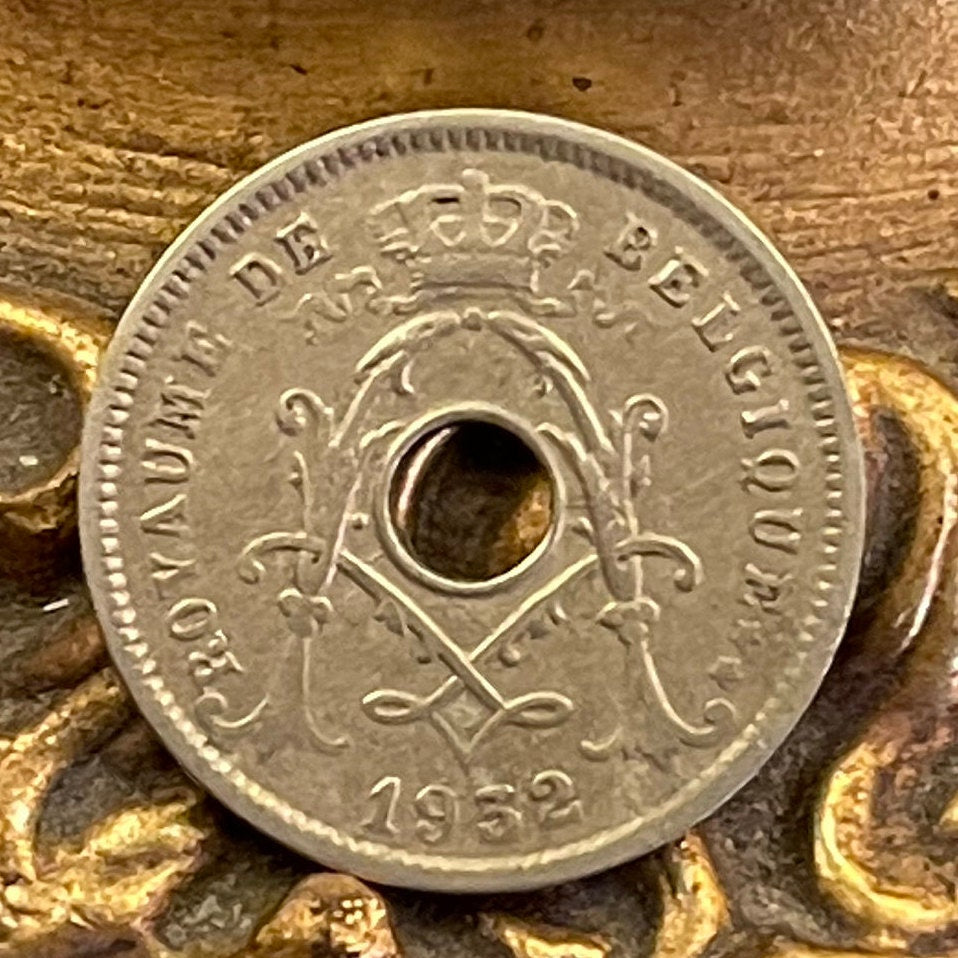elemintalshop
Olive Branch & Hole 5 Centimes Belgium Authentic Coin Money for Jewelry and Craft Making (Peace)
Olive Branch & Hole 5 Centimes Belgium Authentic Coin Money for Jewelry and Craft Making (Peace)
Couldn't load pickup availability
Olive Branch & Hole 5 Centimes Belgium Authentic Coin Charm for Jewelry and Craft Making (1932)
Obverse: The royal monogram of King Albert I is surrounded with legend in French. Date below.
Lettering: ROYAUME DE BELGIQUE
Translation: KINGDOM OF BELGIUM
Reverse: The center hole is flanked by an olive branch and value.
Features
Issuer Belgium
King Albert I (1909-1934)
Type Standard circulation coin
Year 1932
Value 5 Centimes (0.05 BEF)
Currency Franc (1832-2001)
Composition Nickel brass (Cu (.750), Zn (.100), Ni (.150))
Weight 2.5 g
Diameter 19 mm
Thickness 1.36 mm
Shape Round with a round hole
Technique Milled
Orientation Coin alignment ↑↓
Demonetized 29 December 1955
Number N# 5957
References KM# 93, Mor# 431, Schön# 58, LA# BFM-25
Wikipedia:
The olive branch is a symbol of peace or victory allegedly deriving from the customs of ancient Greece, particularly regarding supplication to both the gods and persons in power and is found in most cultures of the Mediterranean basin. It became associated with peace in modern Europe and is also used in the Arab world. Despite claims of Ancient Greek origins, the symbol first appears in Ancient Egypt as a symbol of peace many centuries before appearing in ancient Greek mythology.
In Greek tradition, a hiketeria (ἱκετηρία) was an olive branch held by supplicants to show their status as such when approaching persons of power or in temples when supplicating the gods.
In Greek mythology, Athena competed with Poseidon for possession of Athens. Poseidon claimed possession by thrusting his trident into the Acropolis, where a well of sea-water gushed out. Athena took possession by planting the first olive tree beside the well. The court of gods and goddesses ruled that Athena had the better right to the land because she had given it the better gift. Olive wreaths were worn by brides[4] and awarded to olympic victors.
The olive branch was one of the attributes of Eirene on Roman Imperial coins. For example, the reverse of a tetradrachm of Vespasian from Alexandria, 70-71 AD, shows Eirene standing holding a branch upward in her right hand.
The Roman poet Virgil (70–19 BC) associated "the plump olive" with the goddess Pax (the Roman Eirene) and he used the olive branch as a symbol of peace in his Aeneid:
High on the stern Aeneas his stand,
And held a branch of olive in his hand,
While thus he spoke: "The Phrygians' arms you see,
Expelled from Troy, provoked in Italy
By Latian foes, with war unjustly made;
At first affianced, and at last betrayed.
This message bear: The Trojans and their chief
Bring holy peace, and beg the king's relief."
For the Romans, there was an intimate relationship between war and peace, and Mars, the god of war, had another aspect, Mars Pacifer, Mars the bringer of Peace, who is shown on coins of the later Roman Empire bearing an olive branch. Appian describes the use of the olive-branch as a gesture of peace by the enemies of the Roman general Scipio Aemilianus in the Numantine War and by Hasdrubal the Boeotarch of Carthage.
Although peace was associated with the olive branch during the time of the Greeks, the symbolism became even stronger under the Pax Romana when envoys used the olive branch as tokens of peace.
*******
Wikipedia:
Albert I (8 April 1875 – 17 February 1934) reigned as King of the Belgians from 1909 to 1934. He ruled during an eventful period in the history of Belgium, which included the period of World War I (1914–1918), when 90 percent of Belgium was overrun, occupied, and ruled by the German Empire. Other crucial issues included the adoption of the Treaty of Versailles in June 1919, the ruling of the Belgian Congo as an overseas possession of the Kingdom of Belgium along with the League of Nations mandate of Ruanda-Urundi, the reconstruction of Belgium following the war, and the first five years of the Great Depression (1929–1934). King Albert died in a mountaineering accident in eastern Belgium in 1934, at the age of 58, and he was succeeded by his son Leopold III (r. 1934–1951). He is popularly referred to as the "Knight King" (roi-chevalier or koning-ridder) or "Soldier King" (roi-soldat or koning-soldaat) in Belgium in reference to his role during World War I.
Share










Precisely as pictured, fast shipping, packed with care to avoid scratches and dents.
Wonderful coin. Fast delivery. Well packed.
Lovely coin. Fast shipping too
Timely shipping. Nice historic coin
5 stars review from Lori









